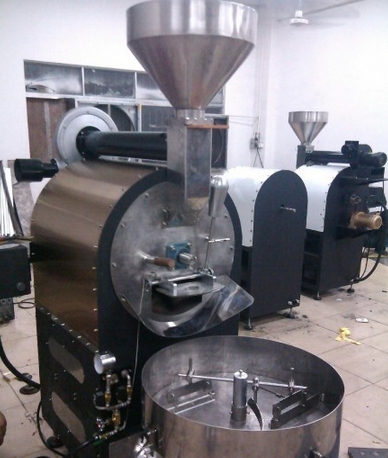The fourth part of the history of coffee-the commercialization of coffee

For many coffee lovers, the period from the mid-19th century to the end of the 20th century was the "dark age" of coffee. In this day and age, coffee has lost the mysterious charm of the Middle East, become commercialized, and frankly become ordinary.
When coffee was first introduced to England in the 17th century, it was enjoyed by all sectors of society. However, the rich will enjoy coffee in their social clubs and pay more attention to the coffee ceremony, while the poor will use coffee as a necessary nutrition, replacing a hot meal with a hot drink, or suppressing hunger. It's only a matter of time before big companies turn coffee into a commodity as technology advances.
Traditionally baked coffee is at home or in a cafe. The practice introduced from the Middle East is to bake an iron pan over a fire until brown, then simply stir-fry another piece. A more complex approach is used in the cafe: a barrel-shaped steel pipe is hung over the fire to help roast the coffee beans in the steel pipe. The amount of coffee baked by these two methods is not very large, and a couple can bake up to a few pounds a day, but this also ensures that the coffee beans are small and fresh. However, with the acceleration of the industrial revolution and mechanization, coffee roasting technology has improved rapidly. The roasting volume of commercial coffee is getting larger and larger, and now it can not only meet small batch production, but also the supply of roasted coffee will only become larger and larger.
Hotel coffee
One way to prolong the freshness of roasted coffee is to wrap it in glutinous rice or gelatinous substances. Then, when the coffee beans are roasted, the glaze will wrap around the coffee beans, which will form a hard film around the coffee beans and become a protective barrier for the coffee beans. The glaze was patented by John Abacor in 1868 and includes the use of one ounce of water, one ounce of Irish moss, half ounce of fish gelatin, half ounce of gelatin, one ounce of sugar, and 24g eggs. The gel can be wrapped in a pound of 454g coffee. Abacor has tried many different glazes before, and over the years, he finally chose sugar-based glazes.
So why are customers willing to buy this kind of coffee? Because coffee will lose its flavor quickly, it should be consumed as soon as possible (within the latest 48 hours). However, it was the brand that established its trump card status as soon as it appeared. Coffee baked in local ovens sometimes produces coffee of unusually good quality, and sometimes coffee of too low quality.
The first coffee brand is to come to the UK is Kenke. In 1923, cooperative Kenyan coffee farmers set up a coffee shop called Kenya Coffee Company, which derives its coffee beans from high-quality coffee beans distributed all over the country. In fact, their store was so popular that their coffee brand changed its name to Kenco in 1962 and soon spread all over Britain.
As regional baking grows into national baking, and then into international baking, they pursue profits increasingly. Traditionally, coffee comes from Arabica coffee bushes. But in the 1850s, France and Portugal began to cultivate different varieties of coffee shrubs, known as Robusta, on the west coast between Gabon and Angola in Africa. Robusta beans are of lower quality and price than Arabica, and they certainly don't taste as good as Arabica. Coffee roasters mix Arabica beans with Robusta beans in order to reduce costs.
The emergence of instant coffee. Although the first commercially produced instant coffee, called Red Coffee, was developed by George Washington and invented by a British chemist living in Guatemala, Nestl é was probably the most famous instant coffee in 1909. In 1930, Nestl é was developed by the Institute (Brazilian Coffee Association). They believe that a new coffee product, which is soluble in hot water but retains its flavor, will help stimulate world coffee sales. After seven years of research and frequent tasting meetings, the scientist Max finally achieved the desired results and launched Nestl é coffee on April 1, 1938, first in Switzerland and then in Britain.
In 1956 some people said that it was the introduction of commercial television as a catalyst that contributed to the success of instant coffee in Britain. It is also reasonable to say that the commercial communication break is too short, and it takes far more time to make a cup of tea than to make a cup of instant coffee. In the 1960s, most tea industries began to produce tea bags, which were invented by Thomas Sullivan more than half a century ago (1904). Tea bags are considered to be more convenient, simpler and faster to brew drinks, and only tea bags can compete with instant coffee.
Coffee entered the business world and began to be advertised in TV commercials. Perhaps the most famous coffee series is the Nestle Coffee Gold blend. First broadcast in 1987, these ads played a chemical reaction between a couple, Anthony's head and Sharon Moon, performing a mini soap opera for people. Advertisements cover the whole country and become a topic that people on the East side often talk about after dinner. This original series of advertisements has been on the air for ten years.
Important Notice :
前街咖啡 FrontStreet Coffee has moved to new addredd:
FrontStreet Coffee Address: 315,Donghua East Road,GuangZhou
Tel:020 38364473
- Prev

Italian Coffee making fancy Coffee recipe
Latte is a classic blend of Italian espresso and milk. Italians also like to use latte as a breakfast drink. In the Italian kitchen in the morning. Coffee and milk are usually brewed on a sunny stove. Italians who drink lattes like milk rather than espresso. Only espresso can.
- Next

What are the "chemical" ingredients in a cup of coffee?
The taste is delicious and fragrant. As can be seen from the advertising words of coffee, flavor is the soul of coffee. Recently, "Coffee Flavor Chemistry", co-written by Dr. Zeng Fankui of Lanzhou Institute of Chemical Physics of Chinese Academy of Sciences and Professor ou Shiyi of Food Department of Jinan University, was published by Jinan University Publishing House. This is the first academic monograph on coffee processing in China. Set
Related
- Detailed explanation of Jadeite planting Land in Panamanian Jadeite Manor introduction to the grading system of Jadeite competitive bidding, Red bid, Green bid and Rose Summer
- Story of Coffee planting in Brenka region of Costa Rica Stonehenge Manor anaerobic heavy honey treatment of flavor mouth
- What's on the barrel of Blue Mountain Coffee beans?
- Can American coffee also pull flowers? How to use hot American style to pull out a good-looking pattern?
- Can you make a cold extract with coffee beans? What is the right proportion for cold-extracted coffee formula?
- Indonesian PWN Gold Mandrine Coffee Origin Features Flavor How to Chong? Mandolin coffee is American.
- A brief introduction to the flavor characteristics of Brazilian yellow bourbon coffee beans
- What is the effect of different water quality on the flavor of cold-extracted coffee? What kind of water is best for brewing coffee?
- Why do you think of Rose Summer whenever you mention Panamanian coffee?
- Introduction to the characteristics of authentic blue mountain coffee bean producing areas? What is the CIB Coffee Authority in Jamaica?

